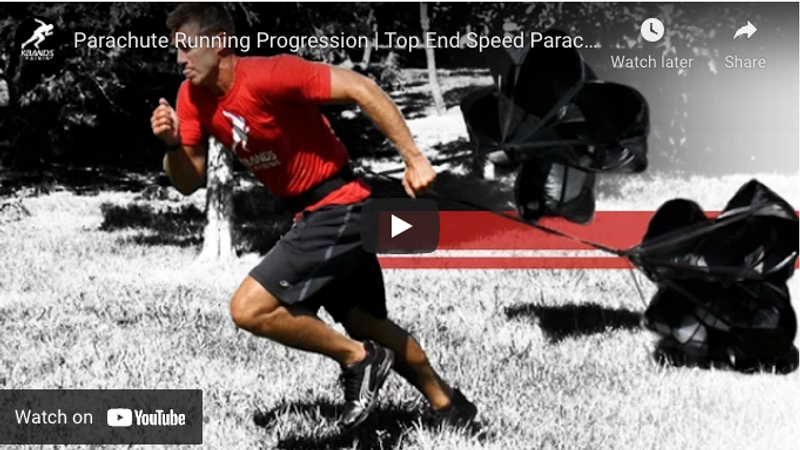Speed Training Parachute Drills: Progressive Speed Workout
The Top End Progressive Speed Chute is one of the key pieces of equipment in the Kbands line of resistance training products, a device that’s lightweight, portable, and simple to use, but highly effective as a training tool. Using the speed chute can add a whole new dimension to any complete sprinting program, and the right speed chute workout can help take any athlete’s running form to a new level. But an effective speed training parachute drill can require some coaching at first, and in order to use the speed chute properly, runners may need to try some practice drills and get used to the feel of added resistance.
The speed training parachute drill in this video can help users adjust to the speed chute and start building the balance, leg strength, and core strength necessary to leave the competition behind on the track. While executing this speed chute workout, runners will need to concentrate on maintaining enough speed to maximize the benefits of the chute, but also keeping the body aligned and maintaining proper running form. The amount of resistance applied to the sprint will have a significant impact on the process.
In order to tackle this challenge, athletes can use the breakdown sheet detailing the moves, reps and sets that apply to each athlete at each distinct level of experience. By keeping the guidelines of the breakdown sheet in mind and maximizing the benefits of every single speed training parachute drill and every speed chute workout, runners can begin to see real progress within about 30 days.
Runners who are not sure where they fall on the breakdown sheet can practice with the speed chute for several sessions in order to determine the appropriate level of resistance. Beginners can try doubling the speed chute, and then drop back to a single chute if too much resistance is compromising their form. Likewise, experienced sprinters can start with one speed chute and add a second as soon as they’re ready to raise the difficultly level.
In both cases, the first two weeks of the speed chute workout will focus on short distances and contained bursts of speed. The second two weeks will extend the speed chute workout over longer distances including up to 40 and 60 yard tracks.
As runners burst forward with the speed chute opening behind them, fatigue will take place faster and running form may be easily compromised. But the moves in this targeted speed training parachute drill will help athletes maintain form in the arms, upper body, legs and feet as this fatigue sets in. Runners should apply these moves and maintain close attention to form and the development of muscle memory while they maintain speed.
Speed Training Parachute Drill: Arms
For the first section of this speed training parachute drill, athletes can sit on the floor in order to isolate the muscles of the upper body. The legs can be extended forward with the knees straight, and the arms can be held at the sides and bent at the elbow in a 90 degree angle. At the signal, runners will swing the arms forward and back in a regular rhythm that moves from fast to slow and back again. At all times, the palms should stay open the arms should stay bent and under control.
Athletes should complete two to three sets of this arm action drill for about 20 to 30 seconds each.
Speed Training Parachute Drill: Single Leg Drive Through
For the second portion of the speed training parachute drill, athletes will need to stand up and lean against a stable structure in order to isolate the muscles of the lower body. As demonstrated Single Leg Drive Through Drill, the athlete will plant one foot on the ground and both hands on the support structure at a 45 degree angle over the head. The other foot can be lifted off the ground and moved in a circle in a rapid cycling motion. This part of the speed chute workout can be completed in two to three sets of twenty seconds each.
Speed Training Parachute Drill: To End Speed Running Parachute
For the primary portion of the speed chute drill, athletes will need: the breakdown sheet, several speed and agility cones, and two top end speed running parachutes. Athletes will work through the requirements listed on the breakdown sheet over the course of four weeks, starting at the beginning and moving through the cycle two weeks at a time.
First, runners will attach a single speed chute to the belt and begin moving through the speed chute workout one move at a time. If runners are maximizing the speed chute, maintaining form, and not getting fatigued, they can add the second chute for greater resistance. If doubling the speed chute adds too much resistance, athletes can drop back down to one.
The speed chute should fully open and stay open during the entire length of the sprint. Ideally, the motion and drag of the speed chute should also be easy for runners to control. During outdoor running under windy conditions, this may resent a challenge. Most teams and runners will want to use the speed chute and execute the end speed running parachute drill either indoors or on non-windy days, but runners who don’t mind some added difficultly can use them outdoors on any given day. Just keep in mind that the resistance and difficultly provided by the open speed chute should never cause the form to break down. The arms should stay close to the body, the flexion of the feet should stay relaxed and natural, and the back should stay bent during the run at a natural angle.
If any of these elements of form start to fail, coaches should recognize the problem and either correct the runner or decrease the resistance. For more speed chute workout drills and speed running parachute drills, athletes and coaches can explore the resources available on KbandsTraining.com.

